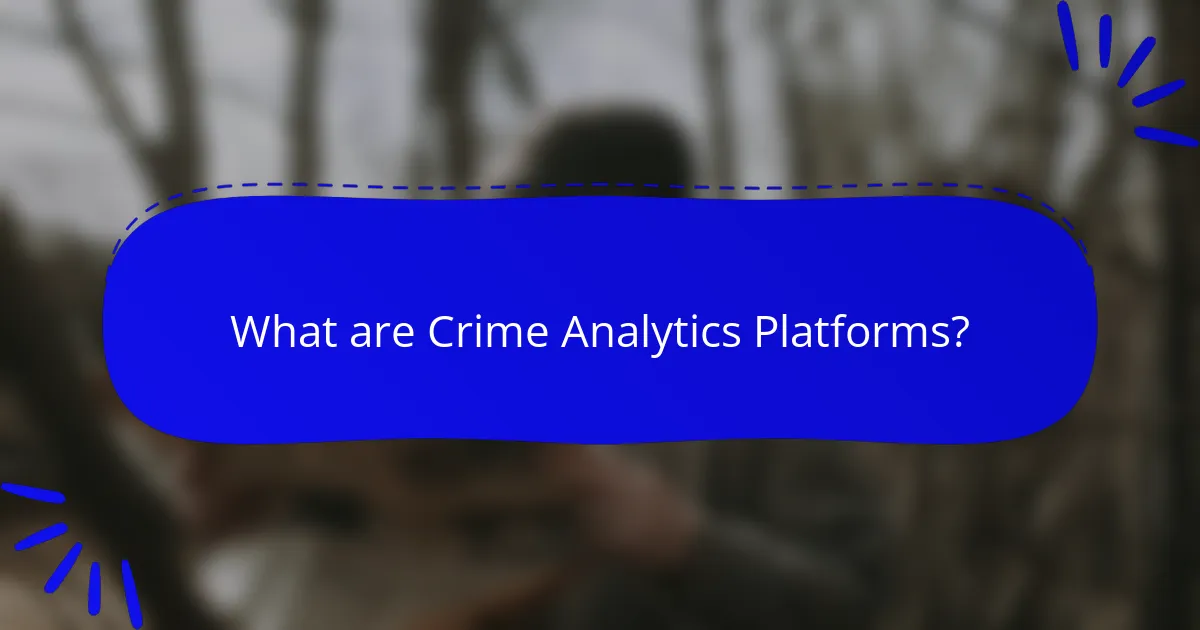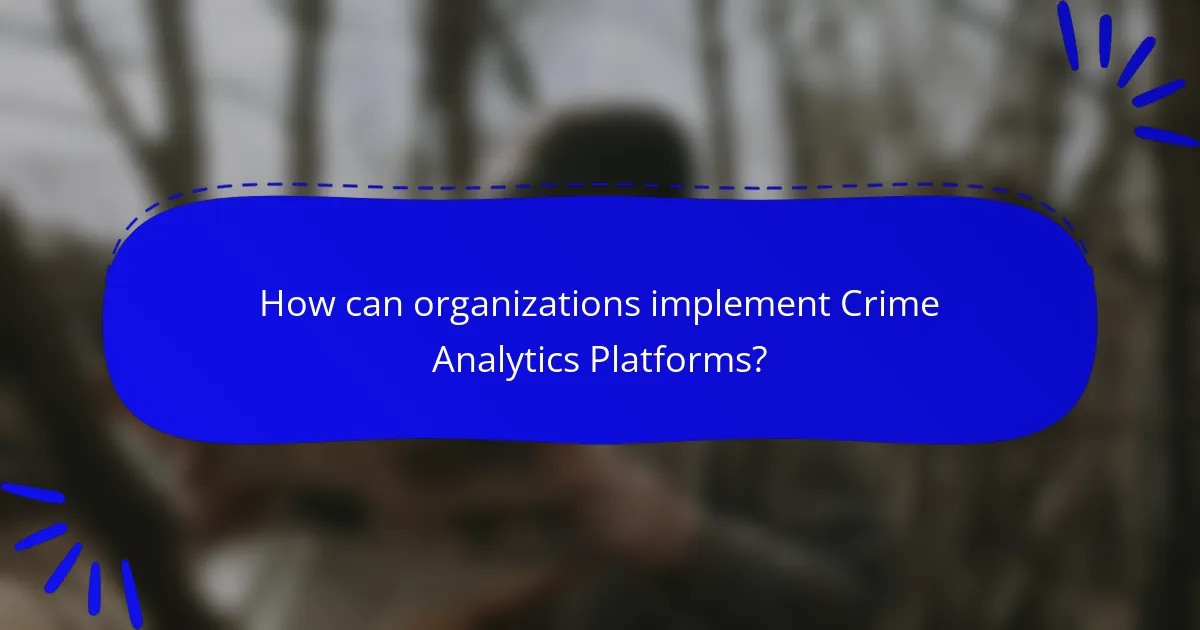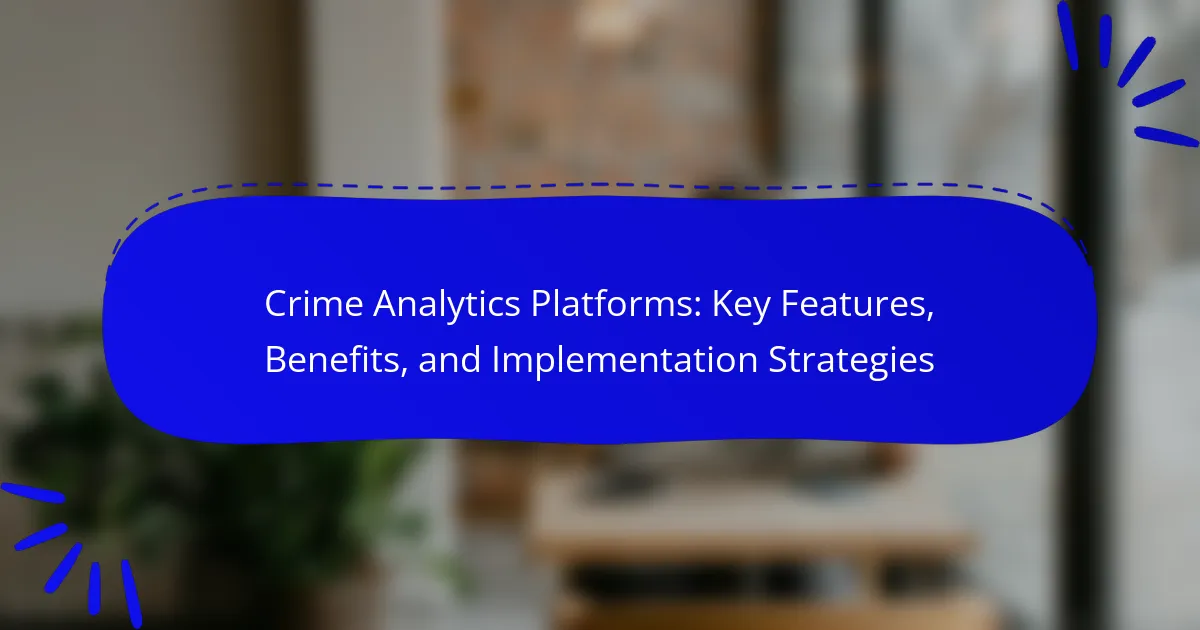
What are Crime Analytics Platforms?
Crime analytics platforms are software systems designed to analyze crime data. They help law enforcement agencies identify patterns and trends in criminal activity. These platforms utilize data mining, statistical analysis, and machine learning techniques. They can process large volumes of data from various sources, including police reports and social media. Crime analytics platforms enhance decision-making and resource allocation for police departments. They provide insights that improve public safety and crime prevention strategies. Studies show that agencies using these platforms can reduce crime rates more effectively. For example, cities employing predictive policing have reported significant decreases in specific crime categories.
How do Crime Analytics Platforms function?
Crime analytics platforms function by collecting, analyzing, and visualizing crime data. These platforms aggregate data from various sources, including police reports, social media, and public records. Advanced algorithms process this data to identify patterns and trends in criminal activity. Visualization tools present the analyzed data in user-friendly formats, such as maps and charts. Law enforcement agencies use these insights to make informed decisions. The platforms enhance resource allocation and improve crime prevention strategies. Studies show that data-driven approaches can reduce crime rates by up to 30%.
What technologies are utilized in Crime Analytics Platforms?
Crime analytics platforms utilize various technologies to analyze crime data effectively. These technologies include machine learning algorithms for predictive analysis. They also employ geographic information systems (GIS) for spatial analysis of crime patterns. Data visualization tools are used to present insights in an understandable format. Additionally, big data technologies manage large volumes of data efficiently. Cloud computing is often utilized for scalability and accessibility. Finally, data mining techniques extract valuable information from datasets. These technologies collectively enhance the ability to understand and respond to crime trends.
How do data sources integrate into Crime Analytics Platforms?
Data sources integrate into Crime Analytics Platforms through data ingestion, processing, and visualization. These platforms collect data from various sources such as law enforcement databases, social media, and public records. The integration process involves standardizing data formats for consistency. Data is then analyzed using algorithms to identify patterns and trends. Visualization tools present this data in an accessible manner. This integration enhances decision-making for law enforcement agencies. Studies show that effective data integration can lead to a 20% increase in crime-solving rates.
What are the key features of Crime Analytics Platforms?
Key features of Crime Analytics Platforms include data integration, predictive analytics, and visualization tools. Data integration allows platforms to gather information from various sources, such as police reports and social media. Predictive analytics helps identify potential crime hotspots based on historical data trends. Visualization tools present data in user-friendly formats, such as maps and graphs. Real-time monitoring enables law enforcement to respond quickly to emerging situations. Reporting capabilities facilitate the generation of detailed analytics reports for strategic planning. User access controls ensure data security and compliance with regulations. These features collectively enhance law enforcement’s ability to prevent and respond to crime effectively.
What analytical tools are commonly included in these platforms?
Crime analytics platforms commonly include tools such as predictive analytics, data visualization, and geospatial analysis. Predictive analytics helps identify potential crime hotspots based on historical data patterns. Data visualization tools present complex data in an understandable format, aiding in decision-making. Geospatial analysis allows law enforcement to map crime incidents geographically. Other tools may include social network analysis and crime trend analysis. These tools enhance the ability to analyze and respond to crime effectively.
How do visualization features enhance data interpretation?
Visualization features enhance data interpretation by transforming complex datasets into easily understandable visual formats. These features allow users to identify patterns and trends quickly. For example, heat maps can illustrate crime hotspots effectively. Charts and graphs simplify the comparison of different data sets. Interactive dashboards enable users to explore data dynamically. This interactivity fosters deeper insights into the underlying data. Research indicates that visualizations improve information retention by up to 65%. Overall, visualization features make data analysis more intuitive and actionable.
What benefits do Crime Analytics Platforms provide?
Crime Analytics Platforms provide enhanced data analysis for law enforcement agencies. They enable the identification of crime patterns and trends. These platforms facilitate predictive policing, allowing agencies to allocate resources effectively. They improve decision-making through real-time data visualization. Additionally, they enhance collaboration among different departments and jurisdictions. Crime Analytics Platforms also foster community engagement by sharing insights with the public. They can reduce crime rates by enabling proactive measures. Studies show that agencies using these platforms see a measurable decrease in crime incidents.
How do these platforms improve law enforcement efficiency?
Crime analytics platforms improve law enforcement efficiency by providing data-driven insights and streamlined processes. These platforms aggregate vast amounts of data from various sources. They utilize advanced analytics to identify crime patterns and trends. This enables law enforcement agencies to allocate resources more effectively. For example, predictive policing tools can forecast potential crime hotspots. This allows officers to proactively increase patrols in those areas. Additionally, these platforms enhance collaboration among different agencies. By sharing information in real-time, they reduce response times to incidents. Studies have shown that agencies using crime analytics report a reduction in crime rates. This demonstrates the tangible benefits of implementing such platforms in law enforcement.
What impact do Crime Analytics Platforms have on community safety?
Crime Analytics Platforms significantly enhance community safety by providing data-driven insights for law enforcement agencies. These platforms analyze crime patterns and trends to predict potential criminal activities. They enable police departments to allocate resources more effectively, focusing on high-crime areas. Studies show that cities using these platforms have experienced a reduction in crime rates. For example, a report from the Police Executive Research Forum found that predictive policing led to a 30% decrease in property crimes in certain jurisdictions. Additionally, these platforms foster community engagement by sharing data with residents, promoting transparency, and encouraging collaboration. Overall, Crime Analytics Platforms play a crucial role in improving public safety and community trust in law enforcement.

How can organizations implement Crime Analytics Platforms?
Organizations can implement Crime Analytics Platforms by following a structured approach. First, they need to assess their specific needs and objectives for crime analysis. This involves identifying the types of data they require and the analytical outcomes they aim to achieve. Next, organizations should select appropriate software solutions that align with their needs. These solutions often include tools for data visualization, predictive analytics, and real-time reporting.
After selecting the software, organizations must integrate it with existing data sources. This may involve connecting databases, crime reports, and other relevant information systems. Training staff on how to use the platform effectively is crucial for successful implementation. This ensures that users can interpret data and generate actionable insights.
Additionally, organizations should establish a governance framework to manage data privacy and compliance. Regularly reviewing and updating the platform based on user feedback and technological advancements is also important. According to a report by the International Association of Chiefs of Police, effective implementation of crime analytics can lead to a 20% reduction in crime rates in some jurisdictions.
What steps are involved in implementing a Crime Analytics Platform?
The steps involved in implementing a Crime Analytics Platform include defining objectives, selecting technology, and data integration. First, organizations must identify their specific goals for the platform. This may involve reducing crime rates or improving resource allocation. Next, selecting the appropriate technology is crucial. This includes evaluating software options and ensuring they align with the defined objectives. Data integration follows, where existing data sources are connected to the platform. This step ensures that the platform has access to relevant and accurate data. Training staff is also essential for effective use. Personnel must understand how to operate the platform and interpret the data. Finally, ongoing evaluation and adjustment are necessary. This ensures that the platform continues to meet the organization’s needs and adapts to changing circumstances.
How do organizations assess their needs before implementation?
Organizations assess their needs before implementation by conducting a thorough analysis of their current processes and challenges. They gather input from stakeholders to identify specific requirements. This often includes surveys, interviews, and workshops to capture diverse perspectives. Organizations also review existing data to pinpoint gaps and areas for improvement. Benchmarking against industry standards can help in understanding best practices. Additionally, they may perform a cost-benefit analysis to evaluate potential solutions. This method ensures alignment with organizational goals and resource availability. By systematically assessing needs, organizations can make informed decisions that enhance the effectiveness of crime analytics platforms.
What challenges might arise during the implementation process?
Challenges during the implementation process of crime analytics platforms can include data integration issues. Organizations often struggle to consolidate data from various sources. This can lead to incomplete or inaccurate datasets. Resistance to change among staff can also impede implementation. Employees may be hesitant to adopt new technologies or workflows. Additionally, technical difficulties can arise, such as software compatibility problems. These issues can delay the deployment of the platform. Limited budget and resources can further complicate implementation efforts. Organizations may find it challenging to allocate sufficient funds for training and support. Lastly, compliance with legal and ethical standards presents another hurdle. Ensuring that data usage aligns with regulations is crucial for successful implementation.
How can organizations ensure successful adoption of Crime Analytics Platforms?
Organizations can ensure successful adoption of Crime Analytics Platforms by focusing on user training and engagement. Providing comprehensive training helps users understand the platform’s functionalities. Engaged users are more likely to utilize the platform effectively. Organizations should also establish clear goals for analytics use. This aligns the platform’s capabilities with operational needs. Regular feedback sessions can address user concerns and improve platform usability. Additionally, integrating the platform with existing systems enhances workflow efficiency. Data quality is crucial; ensuring accurate and relevant data boosts analytics effectiveness. Lastly, leadership support fosters a culture that values data-driven decision-making.
What training is necessary for effective use of these platforms?
Effective use of crime analytics platforms requires specialized training in data analysis and interpretation. Users must understand the underlying algorithms and statistical methods used in the platforms. Training should cover data visualization techniques to present findings clearly. Familiarity with legal and ethical considerations in data handling is essential. Additionally, training should include practical exercises using the platform’s interface. Users should also learn how to integrate external data sources for comprehensive analysis. Ongoing education is beneficial to stay updated on new features and best practices.
How can ongoing support be structured for users?
Ongoing support for users can be structured through multiple channels. These channels include dedicated help desks, online resources, and community forums. Help desks provide direct assistance via phone or chat. Online resources can include user manuals, FAQs, and video tutorials. Community forums allow users to share experiences and solutions. Regular training sessions can enhance user skills and platform understanding. Feedback mechanisms can help identify user needs and improve support services. Consistent updates and communication keep users informed about new features and troubleshooting tips. This multi-faceted approach ensures users receive comprehensive support tailored to their needs.

What are the future trends in Crime Analytics Platforms?
Future trends in crime analytics platforms include the integration of artificial intelligence and machine learning. These technologies enhance predictive analytics capabilities. They allow for more accurate crime forecasting and resource allocation. Real-time data processing is also becoming essential. Platforms are increasingly utilizing IoT devices for immediate data collection. This shift improves situational awareness for law enforcement. Furthermore, data visualization tools are evolving to present complex data intuitively. Enhanced collaboration features among agencies are also emerging. These trends aim to foster a more proactive approach to crime prevention.
How is technology evolving in the field of crime analytics?
Technology is evolving in the field of crime analytics through advancements in artificial intelligence and machine learning. These technologies enhance data processing capabilities for analyzing large datasets. Predictive analytics is becoming more sophisticated, allowing law enforcement to anticipate crime patterns. Real-time data integration is improving situational awareness for officers on the ground. Geographic information systems (GIS) are being utilized to visualize crime trends spatially. Mobile applications are providing officers with instant access to crime data. Cloud computing is facilitating collaboration among agencies by enabling data sharing. Overall, these technological advancements are leading to more effective crime prevention and response strategies.
What role will artificial intelligence play in the future of these platforms?
Artificial intelligence will play a crucial role in enhancing crime analytics platforms. It will improve data processing capabilities, allowing for faster analysis of large datasets. AI algorithms can identify patterns and trends that human analysts might miss. This capability will lead to more accurate predictions of criminal activity. Machine learning models can adapt over time, refining their predictions based on new data. AI will also facilitate real-time monitoring and alerts for law enforcement agencies. According to a report by the International Association of Chiefs of Police, AI can reduce crime rates by up to 20% through predictive policing. Overall, AI is set to transform the efficiency and effectiveness of crime analytics platforms.
How might data privacy concerns shape the development of Crime Analytics Platforms?
Data privacy concerns significantly shape the development of Crime Analytics Platforms. These platforms must prioritize user data protection to comply with regulations like GDPR and CCPA. Developers often implement robust encryption methods to safeguard sensitive information. Additionally, transparency in data usage builds public trust. Organizations might limit data collection to only what is necessary for analysis. This approach minimizes risks associated with data breaches. Regular audits and assessments ensure compliance with privacy standards. Ultimately, addressing privacy concerns can enhance the platform’s credibility and effectiveness.
What best practices should organizations follow when using Crime Analytics Platforms?
Organizations should follow several best practices when using Crime Analytics Platforms. First, they must ensure data quality and accuracy. Reliable data enhances the effectiveness of analytics. Second, organizations should prioritize user training. Well-trained personnel can maximize platform capabilities. Third, they need to establish clear objectives. Defined goals guide data analysis and decision-making. Fourth, organizations should implement data privacy and security measures. Protecting sensitive information is crucial for maintaining public trust. Fifth, collaboration with law enforcement and community stakeholders is essential. Engaging with these entities leads to better insights and outcomes. Lastly, organizations should regularly evaluate and update their analytics strategies. Continuous improvement ensures relevance and effectiveness in crime prevention efforts.
How can organizations leverage data to enhance crime prevention strategies?
Organizations can leverage data to enhance crime prevention strategies by utilizing advanced analytics and predictive modeling. By analyzing historical crime data, organizations can identify patterns and trends. This allows for the allocation of resources to high-risk areas. Real-time data collection from various sources, such as social media and surveillance systems, can provide immediate insights.
For example, the Los Angeles Police Department uses data-driven approaches to deploy officers effectively. According to a study by the Urban Institute, data analytics can reduce crime rates by 30% in targeted areas. Organizations can also implement community engagement tools to gather local insights. This data-driven strategy fosters collaboration between law enforcement and communities.
Ultimately, leveraging data enhances decision-making and improves overall effectiveness in crime prevention.
What metrics should be monitored to evaluate the effectiveness of Crime Analytics Platforms?
Key metrics to monitor for evaluating the effectiveness of Crime Analytics Platforms include crime reduction rates, response times, and data accuracy. Crime reduction rates measure the decrease in crime incidents over time, indicating the platform’s impact. Response times assess how quickly law enforcement can act on insights provided by the platform. Data accuracy evaluates the reliability of the information processed and analyzed, which is crucial for informed decision-making. Additionally, user engagement metrics reflect how effectively officers utilize the platform in their daily operations. Finally, cost-effectiveness analyzes the financial return on investment relative to crime reduction achieved. These metrics collectively provide a comprehensive view of a platform’s effectiveness in enhancing public safety.
Crime analytics platforms are software systems designed to analyze crime data, helping law enforcement agencies identify patterns and trends in criminal activity. These platforms utilize advanced technologies such as machine learning, data mining, and geographic information systems to process large volumes of data from diverse sources, enhancing decision-making and resource allocation. Key features include predictive analytics, data integration, and visualization tools, all aimed at improving public safety and crime prevention strategies. The article also explores implementation strategies, challenges, and the future trends in crime analytics, emphasizing the importance of data privacy and effective user training for successful adoption.
